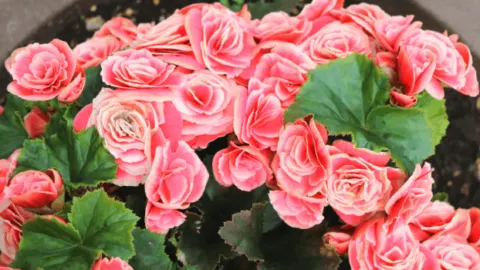How do you care for an Elatior begonia? Elatior Begonias are a wonderful and bushy member of the Begonia family that is semi-tuberous. Begonia elatior is specifically grown to have a long indoor flowering season.
They are the perfect indoor plant, requiring shorter bloom days, and are commonly nicknamed Winter Begonias.
These gorgeous and resilient hybrids are considered an everblooming species. They can bloom year-round. Here is what you need to know about Elatior Begonia care.
Begonia elatior Takeaways
| Species | Begonia elatior |
| Synonyms | Elatior Begonia,Rieger Begonia,Begonia x hiemalis |
| Family | Begoniaceae |
| Genus | Begonia |
| Growth | Bushy |
| Height | 1.5 feet |
| Width | 1 foot |
| Soil | Potting soil, peat moss, perlite, vermiculite |
| Watering | Water every 5 to 7 days |
| Light | Bright indirect |
| Temperature | 65 to 75°F |
| Humidity | 40-60% |
| Fertilizer | Fertilize twice a month in spring and summer |
| Propagation | Leaf cuttings, stem cuttings |
| Toxicity | Toxic to pets such as cats and dogs and horses. It contains soluble calcium oxalates. |
Table of Contents
Elatior Begonia Care
To care for an Elatior Begonia provide bright indirect light. Use fast-draining soil consisting of potting soil and perlite. Provide a temperature between 60-75°F (16-24°C). Water about once every 7 days once the soil is almost dry. Fertilize every two weeks in spring and summer. Reduce to every 3-4 weeks in autumn and winter.
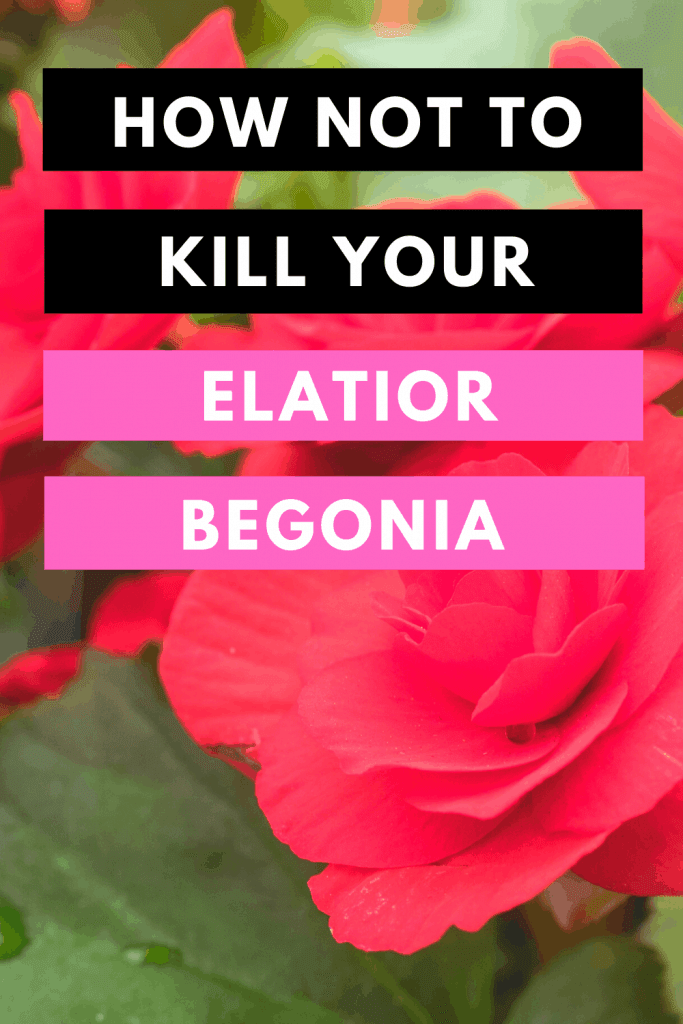
What is an Elatior Begonia?
The botanical name for the Elatior begonia is Begonia X Hiemalis. The word Hiemalis means winter flowering. Originally, these plants were just that. X means that this Begonia is a cross. It is a cross between a wax begonia and a tuberous begonia.
Clemson University states that flowering plants are available all year.
The flowers are delicate and small and grow on brittle stems. They can be a single or a double flower and range in color from white to yellow, orange, and pink. The foliage is green and heart-shaped, and full-bodied.
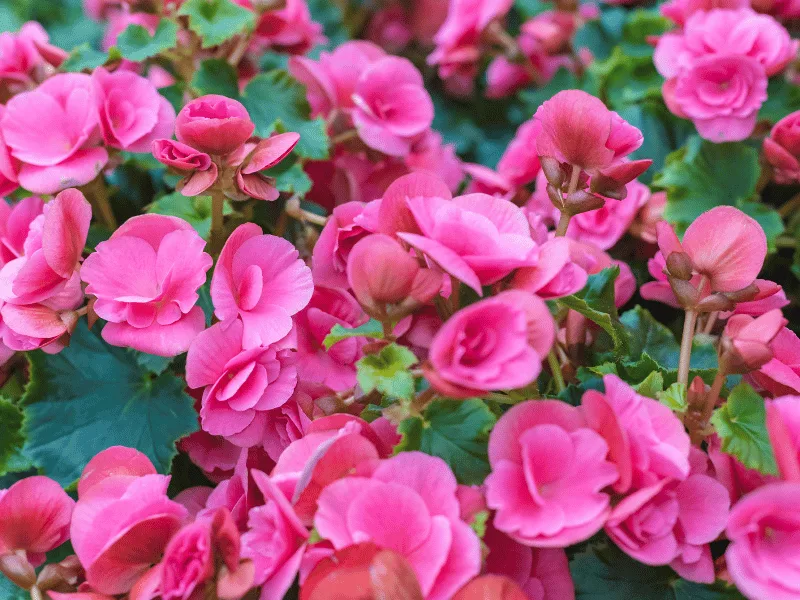
What are Rieger Begonias (Begonia x hiemalis)?
Rieger Begonia, known as Begonia x hiemalis by their scientific name, are flowering Begonias. This category of Begonias was created by cloning a tuberous Begonia with a wax Begonia.
By crossing a Begonia species that was flowering in summer with one that blooms in winter, a cross was created that blooms all year round.
The Hiemalis Begonia is also known as Elatior Begonia.
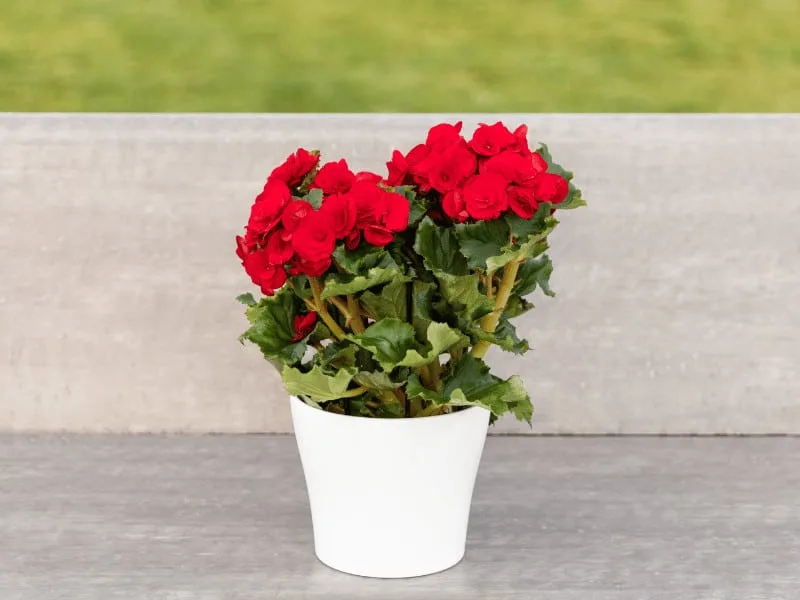
Caring for an Elatior Begonia
Soil
Elatior Begonia grows well in any high-quality, fast-draining soil. These flowering plants need a good anchoring soil to accommodate top growth.
I ensure my Elatior Begonia is in neutral pH soil with two parts soil and one-part perlite. I have had excellent results with this mixture. I use it for most of my indoor Begonia plants.
I find it works well for anchoring roots, feeding the plant, and drainage. For me, that is a three-part win! I have read that African Violet soil is also ideal for Rieger Begonias, although I have not tried one myself.
I have made my mix, however, out of two cups of peat moss, one cup of vermiculite, and one cup of perlite. Another option is mixing one cup of peat moss and one cup of vermiculite at a 50:50 ratio.
Light
Elatior Begonia does well with indirect sun or even partial shade.
I keep mine away from the direct sun on a bright shelf. If you live in a subtropical area, they can be planted outdoors but will not do well with direct sun. They also need an environment that is not too windy.
Watering
Water about every 7 days so it doesn’t get dry between watering. I stick my finger in the soil and water it when the top two inches (5 cm) are not quite dry but will be in another day.
I water it fully, allowing the excess to drain through the draining holes in the bottom of the pot, and I keep the soil damp but never wet. They prefer to have moisture, so never letting them dry out completely is key.
A layer of mulch over the soil is a good idea for Elatior Begonia care. These plants do not tolerate a wet environment on their leaves, so be careful not to splash them too much during watering.
Temperature
Like all of the Begonia family, Begonia x hiemalis prefers daily indoor temperatures of 75 degrees Fahrenheit (24 degrees Celsius) with a low of 60 degrees Fahrenheit (16 degrees Celsius) at night.
They can tolerate higher temperatures as long as they have protection from the harsh sun rays. They are not frost intolerant and do not like being exposed to elements such as wind.
Humidity
The ideal humidity is between 65-75%.
Since Begonia plants are tropical and subtropical, they thrive in humid conditions. I mist my plants periodically. However, they must be monitored for mildew when misting is part of the regime.
Part of the Elatior Begonia care I would recommend is having a humidifier in a dry climate.
This has made a big difference for me in my Elatior Begonia growth. I leave it on all year round to keep the room at around 65%. I would not recommend going lower than 50% humidity; I never let mine get higher than 75%.
Fertilizer
I fertilize my Elatior Begonia every 2 weeks in spring and summer using a well-balanced liquid fertilizer. The reason for this frequent fertilization is that this plant blooms often and needs lots of energy for its flower.
I add plant food every three to four weeks in autumn and winter.
You can also use a slow-release fertilizer. Begonias prefer fertilizer poured around the base.
Growth
If you provide your Elatior Begonia with good care, it will grow to an average size of 10-18 inches tall and wide (25-46cm). They are densely clustered plants and have a mounding habit when growing.
Potting and repotting
I always give my Elatior Begonia a well-draining pot with enough drainage holes in the bottom. All Begonias like to be root bound, so repotting is often unnecessary.
It is beneficial once the roots fill the pot. Repotting boosts the soil nutrients and allows for proper aeration of the soil. Do not repot your Begonia if there is still loose soil.
A pot that is too large for a Begonia will allow the soil to supply too many nutrients and too much water, and it will wilt.
Begonia Elatior Outdoor Care
You can care for Begonia Elatior outdoors. In cool climates, bring your plants indoors. They are not frost-hardy. The USDA hardiness zones are 8-11 for growing Begonia Elatior outdoors.
I put mine out in their pots in the summer instead of directly planting them in the garden. This means I can bring them in overnight when it gets cool and in the winter.
Before I take them out each summer, I harden the plant. Take it out for an hour or two the first day and place it in indirect sunlight in an area that isn’t windy.
Take it out for three or four hours under the same conditions for the next two or three days. Keep adding time until the plant is out for seven hours during the day.
I don’t leave mine out longer than that on any given day.
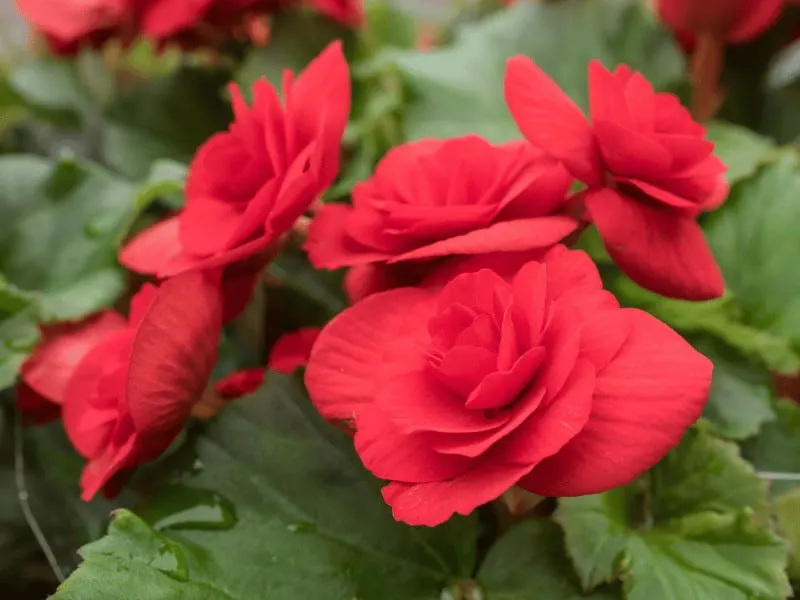
Elatior Begonia: Common Pests
Like most begonias, these plants are not susceptible to lots of plant pests. Check in the joints of the stem periodically for soft cottony masses.
These masses indicate mealybugs. They can be treated with an insecticidal soap and water mixture that is wiped directly onto the leaves and stems, or you can use Neem Oil wiped directly onto the leaves and stems.
Don’t leave the leaves wet after application, which can cause powdery mildew.
If you believe the University of Missouri, common insects on houseplants are:
- Thrips
- Spider mites
- Aphids
- Scale
- Fungus gnats
- Leaf miners
- Whiteflies
Luckily the only pest problem I ever had on my Begonia are mealybugs.
Elatior Begonia Propagation
The easiest way to propagate an Elatior Begonia is to take cuttings from the plant to propagate. You can use either a stem or a leaf cutting.
Any time you are pruning your Elatior Begonia, you can cut a stem or some leaves to propagate.
Cut either a three to four-inch stem section or a few leaves from the mother plant.
If you used a stem cutting, dip it in rooting powder and plant it in soft soil, or just put the stem in water and plant it in soil once the roots begin to grow.
Leaves can be directly planted right into a pot and soil. You can use the whole leaf or leaf sections if you need a lot of plants. To use sections, cut the leaves in sections to plant, ensuring that each section has a portion of the main vein on it before you plant it.
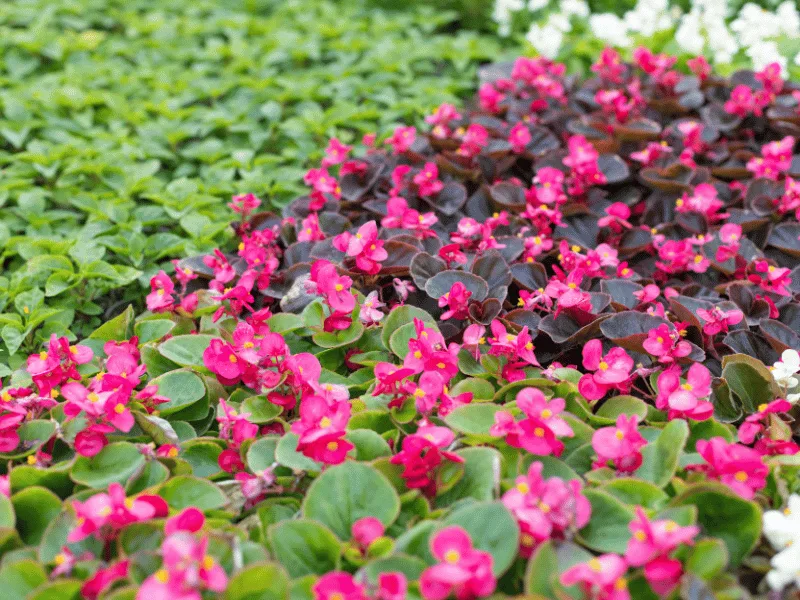
Cuttings can be planted into the same pot as the mother plant, provided there is an inch or so left for root growth in the pot. If not, start them in small seedling cups and transplant them into bigger pots as they grow and get root bound.
It is substantially easier to grow an Elatior Begonia from a cutting than it is to grow them from seeds. You can harvest your own, but, in my experience, it is better to buy them.
I have never had great results from harvesting seeds from my Elatior Begonia. The seeds are very fine and difficult to work with.
If you buy seeds, remember the growth will be slow initially. It is best to start Elatior Begonias early in the season, like January or February.
Light can be sparse at that time of year, so if you don’t have a sunny room to put them in, you may need to purchase
Tips & Tricks for the Well-being of your Elatior Begonia
When you are giving your Elatior Begonia care, a good thing to remember is the humidity levels. I find that my plant flourishes when I have a humidifier in the room with it all year round, although I do adjust it to be slightly more humid in the winter.
I don’t mist my Elatior Begonia often as they are very susceptible to leaf mildew. However, I do wipe the leaves down with Neem oil or rubbing alcohol periodically to make sure pests stay away.
I also ensure that any new cuttings have lots of humidity to grow. The best way to achieve this Elatior Begonia care is to drape a plastic tent over the cuttings to keep the humidity in.
I have also found that good air quality and proper circulation around the plants prevents and combats the powdery mildew they are so susceptible to.
These plants do not need to be repotted often. I have found that all of my begonias struggle a bit when I do repot them, so I wait until the pot is full of roots with not one inch to spare.
If there is even an inch of extra room in the pot, hold off until it has grown that extra inch. When repotting it, use a pot one size bigger than the last one, as it will not grow well if there is more than an inch or so of room in the pot.
I repotted mine into a pot two inches bigger once, and it wilted and drooped for a long period after repotting. I was certain I would lose it, but in the end, it survived. I will never make that mistake again.
Similar Begonia varieties
- Begonia semperflorens (Semperflorens begonia or bedding begonia)
- Begonia fibrous (Fibrous-rooted begonia or cane begonia)
- Begonia x tuberhybrida (Tuberous begonia)
- Begonia rex (Rex begonia)
- Begonia boliviensis (Bolivian begonia)
Frequently Asked Questions
Where can I buy an Elatior Begonia plant?
They are available regularly at garden and home gardening stores. I have also seen them at grocery stores and even on Amazon! Once you have one plant, you can propagate it into many more for years to come with the proper Elatior Begonia care.
Does my Elatior Begonia care need to include regular pruning?
It is a good idea to deadhead the flowers from the plant as needed, and it is a good idea to cut the plant back to a height of two to four inches to encourage new growth. This should be done after blooming is complete. It will encourage new blooms when this is done on a regular schedule. This is also a good time to propagate the cuttings and grow new plants.
Are Elatior Begonia plants toxic to animals?
Elatior Begonia is toxic to pets such as cats and dogs. They can cause swelling and burning in the mouth, vomiting, and liver failure. I keep mine in a closed-off room away from my pets.
Conclusion
Elatior Begonias are a beautiful bushy plant that is easy to maintain and easy to propagate. They prefer being in an indirect light source, requiring a humid but not wet environment.
Elatior Begonias prefer to be rootbound and, as such, don’t need to be repotted much, and as long as they are in a well-draining pot with rich, well-draining soil, they will thrive.
They produce delicate flowers in the summer, which should be deadheaded as they die, and the plant pruned once the blooms are finished.
For proper Elatior Begonia care, remember to keep temperatures warm and humid as they are originally subtropical plants.
They also do very well with a humidifier in the room or in a greenhouse where it is naturally humid. Just be sure to keep them in indirect sunlight, or their delicate foliage will get burnt and die, and don’t let their leaves stay wet because they are very susceptible to leaf mildew.
Overall, these are easy plants to care for that look delightful in a garden or a pot. With great results, I have grown them in larger containers as an accent piece to my greenhouse.
They are pretty and delicate, and when they bloom, they turn any area into a beautiful focal point of white, pink, or yellow. They are a beautiful and affordable addition to any garden or home.

Daniel has been a plant enthusiast for over 20 years. He owns hundreds of houseplants and prepares for the chili growing seasons yearly with great anticipation. His favorite plants are plant species in the Araceae family, such as Monstera, Philodendron, and Anthurium. He also loves gardening and is growing hot peppers, tomatoes, and many more vegetables.

